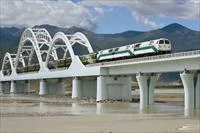Reactive Powder Concrete (RPC) is a developing composite material that will allow the concrete industry to optimize material use, generate economic benefits, and build structures that are strong, durable, and sensitive to the environment. A comparison of the physical, mechanical, and durability properties of RPC and HPC (High-Performance Concrete) shows that RPC possesses better strength (both compressive and flexural) and lower permeability compared to HPC.
Reactive Powder Concrete (RPC) was developed in France in the early 1990s and the world’s first Reactive Powder Concrete structure, the Sherbrooke Bridge in Canada, was erected in July 1997. Reactive Powder Concrete (RPC) is an ultra-high-strength and high ductility cementitious composite with advanced mechanical and physical properties. It consists of a special concrete where the microstructure is optimized by precise gradation of all particles in the mix to yield maximum density. It uses extensively the pozzolanic properties of highly refined silica fume and optimization of the Portland cement chemistry to produce the highest strength hydrates.
The concept of reactive powder concrete was first developed by P. Richard and M. Cheyrezy and RPC was first produced in the early 1990s by researchers at Bouygues’ laboratory in France. A field application of RPC was done on the Pedestrian/Bikeway Bridge in the city of Sherbrooke, Quebec, Canada. RPC was nominated for the 1999 Nova Awards from the Construction Innovation Forum. RPC has been used successfully for the isolation and containment of nuclear wastes in Europe due to its excellent impermeability.
The requirements for HPC used for the nuclear waste containment structures of Indian Nuclear Power Plants are a normal compressive strength, moderate E value, uniform density, good workability, and high durability. There is a need to evaluate RPC regarding its strength and durability to suggest its use for nuclear waste containment structures in the Indian context.
Composition of Reactive Powder Concrete
RPC is composed of very fine powders (cement, sand, quartz powder and silica fume), steel fibres (optional) and superplasticizer. The superplasticizer, used at its optimal dosage, decreases the water to cement ratio (w/c) while improving the workability of the concrete. A very dense matrix is achieved by optimizing the granular packing of the dry fine powders. This compactness gives RPC ultra-high strength and durability. Reactive Powder Concretes have compressive strengths ranging from 200 MPa to 800 MPa.
source: The Concrete Portal

0 comments